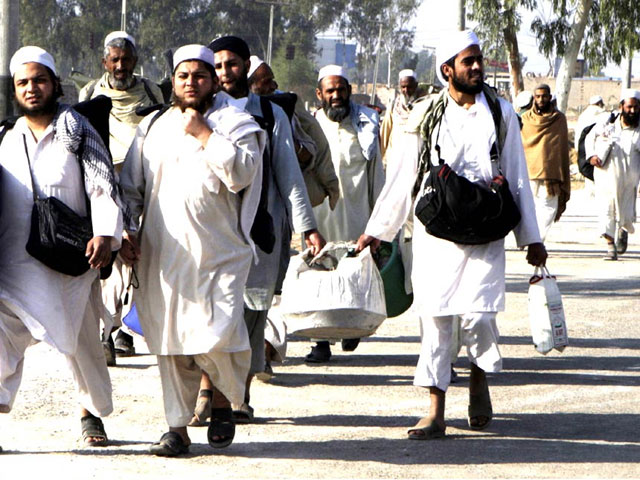
The Tablighi Jamaat: A Soft Islamization from the Ferghana Valley to Russia’s Turkic Regions?
Publication: Eurasia Daily Monitor Volume: 10 Issue: 12
By:

In 2012, Kazakhstan’s law enforcement agencies suppressed the activities of 205 missionaries representing the unregistered religious organization Tablighi Jamaat, Kazakhstani Senator Iran Amirov said. According to the Central Asian republic’s laws, the activity of any unregistered religious organization is prohibited. Therefore, Tablighi Jamaat missionaries had been fined or expelled (Interfax, October 19, 2012).
The Tablighi Jamaat, which roughly translates to the “Society for Spreading Faith,” was founded in the late 1920s in India. It was originally intended as a vehicle for promoting a revival of Islamic piety, and, as such, it placed a heavy emphasis on missionary activity among its membership. The group has traditionally eschewed politics and concentrated its efforts on reinforcing the faith of Muslims. Forming small groups—in Asian countries generally made up of 10–12 individuals and 3–5 people in other parts of the world—Tablighi Jamaat representatives operate globally, both from inside mosques and by propagating their organization’s message “door to door.” Tablighi Jamaat facilitates strict discipline and subordination to the leader, and its members become professional missionaries. Its activists are required to work for the organization 40 days per year, three full days per month, two afternoons per week and two hours every day. Many followers of terrorist and extremist groups have reportedly attended meetings run by Tablighi Jamaat, but widespread jihadist preaching and ties to terrorist activities have not been identified yet. Nevertheless, Tablighi Jamaat is prohibited in Iran, Russia, Tajikistan, Turkmenistan and Uzbekistan. India is also considering banning the organization.
According to Dr. Bakhtiyar Babadjanov, professor of religious studies and chief research fellow at the Oriental Studies Institute under the Academy of Sciences of Uzbekistan, the global mission of the Tablighi Jamaat is the “Islamization” of the world. Regarding alleged extremist components of Tablighi Jamaat, Babadjanov mentioned that “so far I am not aware of political extremist slogans of Tablighi Jamaat. Perhaps, they are not well advertised…” (Ferghananews.com, May 8, 2009). Today, the organization’s main office is based in the Pakistani city of Raiwind, near Lahore. Tablighi Jamaat also has a very influential branch in London.
As Babadjanov notes, Tablighi Jamaat shares many common features with Hizb ut-Tahrir (the popular international Islamic organization, which is active in Central Asia and whose members promote the establishment of a global caliphate). For example, in both organizations members are united in small, local groups, facilitating strict discipline and subordination to the leader. The members of the both organization also have to donate parts of their salaries to their organizations. Moreover, both organizations adhere to the Sunni branch of Islam and expect a similar level of active time commitment from its members. But, unlike Hizb ut-Tahrir, Tablighi Jamaat does not try to establish a caliphate as soon as possible; Tablighi Jamaat members consider Islamization to be a long-term process. The organization, unlike Hizb ut-Tahrir, also tries to avoid open conflicts with authorities (Ferghananews.com, February 13, 2009).
As some Tablighi Jamaat members told the author in July 2007, members of Hizb-ut-Tahrir had tried to establish contact with them. But they politely had explained to them that Tablighi Jamaat does not interfere in politics.
According to Dr. Babadjanov, the first Tablighi Jamaat missionaries visited Central Asia not long after the Soviet Union’s collapse in 1991. First they targeted the Ferghana Valley. The organization is particularly active today in the Kyrgyzstani part of the Ferghana Valley. But now almost all Central Asian members of Tablighi Jamaat are local residents. Central Asian Tablighi Jamaat followers prefer to wear a Pakistani style of dress, and so they look very exotic in the region (Ferghananews.com, February 13, 2009).
Dr. Sergei Abashin, the chief of the Central Asia department of the Russian Ethnology Institute, told Jamestown on January 5 that the Tablighi Jamaat’s activities are today particularly concentrated Kazakhstan and Kyrgyzstan. Due to harsh repressions by Uzbekistan’s and Tajikistan’s authorities (members of the organization were sentenced to a long imprisonment), the activity of Tablighi Jamaat is very low in these republics. Little information can be collected about Tablighi Jamaat’s activity in Turkmenistan, however, according to Dr. Abashin.
Ethnic Kazakhs and Kyrgyz, descendants of nomads, are less religious than Uzbeks and Tajiks. But even in the Kyrgyzstani part of the Ferghana valley, where the ethnic Uzbek diaspora is very numerous, almost all Tablighi Jamaat members are Kyrgyz, whereas most local Hizb ut-Tahrir members are Uzbeks. In fact, in private conversations with the author in July 2007, Tablighi Jamaat missioners specifically noted that they preferred to campaign amongst the Kyrgyz exactly because they are less religious than Uzbeks.
Tablighi Jamaat’s reach is not limited to Central Asia, however, and its members maintain links with like-minded individuals in the Russian Federation. The main regions of Tablighi Jamaat activity in Russia are Tatarstan and Bashkortostan, which are separated from Kazakhstan by Russia’s Orenburg oblast (province). Ethnic Tatars constitute 7.6 percent of the population of the Orenburg oblast; Kazakhs make up six percent, while Bashkirs constitute two percent of the total (Russian Federation Census, 2010). The Orenburg oblast is, thus, the interlink between Turkic ethnic groups living in Russia and Central Asia. At the beginning of Perestroika, some Turkic nationalists told the author that due to this Orenburg link, it would be possible to establish “a Greater Turkistan” from Central Asia to Tatarstan.
The Tablighi Jamaat has, indeed, been quite active in the Orenburg oblast since 2010. In September 2012, more than 500 members of the Tablighi Jamaat movement were arrested in Sol-Iletsk district of Orenburg, which borders on Kazakhstan. Among those arrested were two leaders of the Tablighi Jamaat’s Orenburg branch. During the search of their homes more than 500 copies of religious books with extremist content were confiscated. The investigation reportedly revealed that Tablighi Jamaat missionaries from the United Arab Emirates, Malaysia and Kazakhstan regularly worked in the district (Interfax, September 17, 2012). Notably, ethnic Kazakhs constitute 26 percent of the Sol-Iletsk district’s population, while ethnic Tatars make up ten percent (Russian Federation Census, 2010). It is, therefore, possible to conclude that in recent years, the Tablighi Jamaat has successfully established a continuous zone of operations from the Ferghana Valley all the way to the Turkic regions of Russia.




